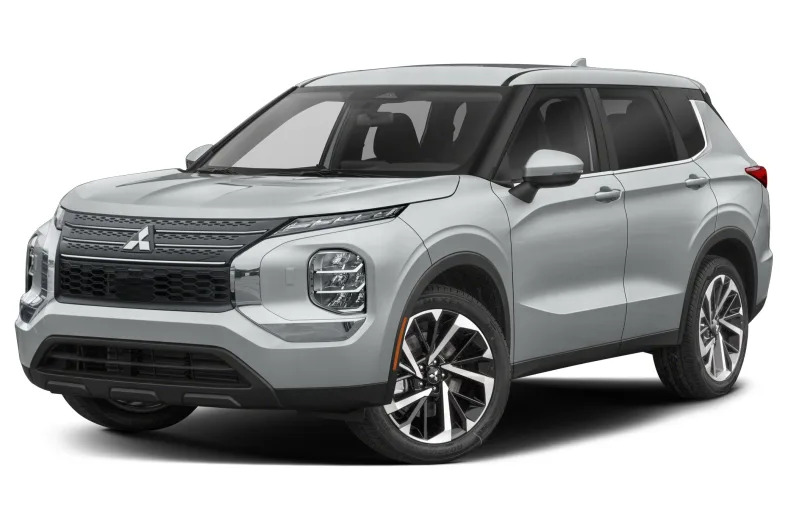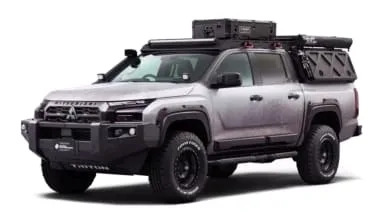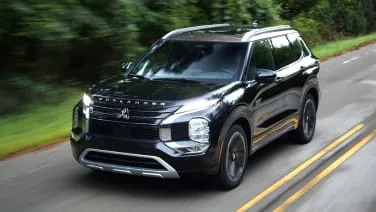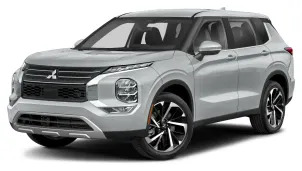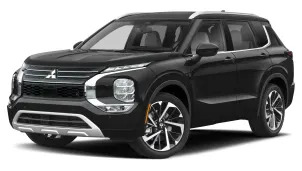2022 Mitsubishi Outlander
Industry
Well, this is a first. Normally, three-row vehicles are so enormous that doing a luggage test with the third row lowered is a total "no kidding" proposition. I'd run out of stuff in my garage long before I'd fill up a Kia Telluride. As such, I only test the space behind the raised third row of three-row SUVs because that can actually be some useful information. The 2022 Mitsubishi Outlander is not a typical three-row SUV, however. It's one of only two SUVs in the compact segment, along with the Volkswagen Tiguan, that offers a third-row seat. As I've already demonstrated, it's not much a seat, but its presence and the need to accommodate it does mean the Outlander has one of the largest cargo volumes in the compact segment. As such, what we're getting here is the first Double Luggage Test© whereby I'll be treating the Outlander like both a compact SUV and a three-row one, testing it with both the third row raised and lowered. Right!? Pretty damned exciting. Test 1! Here's what you get with third row raised. On paper, Mitsubishi says this is 11.7 cubic-feet, which is indeed the smallest three-row number I've come across while luggage testing. Congratulations Cadillac XT6, you're no longer last! Wait, hold that thought ... Thanks to those comically tall head restraints and the Outlander's D pillar shape, I could actually safely place the fancy bag on top without it flying forward or excessively blocking rearward visibility (the two reasons I don't load to the roof in these tests). You can see that visibility below right. Below left you can see the 12.6-cubic-foot Cadillac XT6, which could not fit the fancy bag as such (though, obviously, you could fit something). So, sorry XT6, you're in last again. Mwa mwa. Ah, but what about under-floor space. There's indeed some available. It houses the cargo cover encased in a foam mold that also houses those comically tall headrests when not in use. Remove it all, and there is a decent amount of extra space unearthed, which could theoretically free up some extra space if you left the rigid floor open. That's not the same as vehicles like the Honda Pilot and Kia Telluride, though, which more obviously intend you to use the under-floor space in such a manner. Test 2! With the third-row lowered and the second-row reclined to a natural position, this is the space available. The specs say it's 33.5 cubic-feet, which falls short of the class-leading Honda CR-V (39.2), Toyota RAV4 (37.5) and Hyundai Tucson (38.7). The difference almost certainly comes down to the presence of the third row. Note how much vertical space there is behind the wheel wells — the floor depth would likely be closer to those outer areas if this was only a two-row model. Cargo capacity would also, therefore, be closer to its similarly sized competitors. Of course, these are just numbers we're talking about. As in every luggage test I do, I use two …
Full Review
Well, this is a first. Normally, three-row vehicles are so enormous that doing a luggage test with the third row lowered is a total "no kidding" proposition. I'd run out of stuff in my garage long before I'd fill up a Kia Telluride. As such, I only test the space behind the raised third row of three-row SUVs because that can actually be some useful information. The 2022 Mitsubishi Outlander is not a typical three-row SUV, however. It's one of only two SUVs in the compact segment, along with the Volkswagen Tiguan, that offers a third-row seat. As I've already demonstrated, it's not much a seat, but its presence and the need to accommodate it does mean the Outlander has one of the largest cargo volumes in the compact segment. As such, what we're getting here is the first Double Luggage Test© whereby I'll be treating the Outlander like both a compact SUV and a three-row one, testing it with both the third row raised and lowered. Right!? Pretty damned exciting. Test 1! Here's what you get with third row raised. On paper, Mitsubishi says this is 11.7 cubic-feet, which is indeed the smallest three-row number I've come across while luggage testing. Congratulations Cadillac XT6, you're no longer last! Wait, hold that thought ... Thanks to those comically tall head restraints and the Outlander's D pillar shape, I could actually safely place the fancy bag on top without it flying forward or excessively blocking rearward visibility (the two reasons I don't load to the roof in these tests). You can see that visibility below right. Below left you can see the 12.6-cubic-foot Cadillac XT6, which could not fit the fancy bag as such (though, obviously, you could fit something). So, sorry XT6, you're in last again. Mwa mwa. Ah, but what about under-floor space. There's indeed some available. It houses the cargo cover encased in a foam mold that also houses those comically tall headrests when not in use. Remove it all, and there is a decent amount of extra space unearthed, which could theoretically free up some extra space if you left the rigid floor open. That's not the same as vehicles like the Honda Pilot and Kia Telluride, though, which more obviously intend you to use the under-floor space in such a manner. Test 2! With the third-row lowered and the second-row reclined to a natural position, this is the space available. The specs say it's 33.5 cubic-feet, which falls short of the class-leading Honda CR-V (39.2), Toyota RAV4 (37.5) and Hyundai Tucson (38.7). The difference almost certainly comes down to the presence of the third row. Note how much vertical space there is behind the wheel wells — the floor depth would likely be closer to those outer areas if this was only a two-row model. Cargo capacity would also, therefore, be closer to its similarly sized competitors. Of course, these are just numbers we're talking about. As in every luggage test I do, I use two …
Hide Full Review
Hide Full Review
Retail Price
$26,995 - $35,345
MSRP / Window Sticker Price
| Engine | 2.5L I-4 |
| MPG | Up to 24 city / 31 highway |
| Seating | 7 Passengers |
| Transmission | 2-spd CVT w/OD |
| Power | 181 @ 6000 rpm |
| Drivetrain | S-AWC four-wheel, front-wheel |
| Curb Weight | 3,593 - 3,803 lbs |
Smart Buy Program is powered by 

